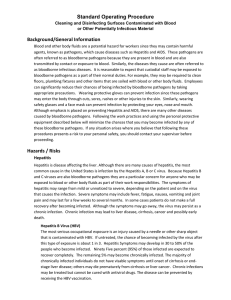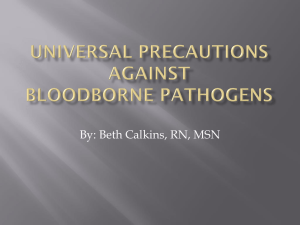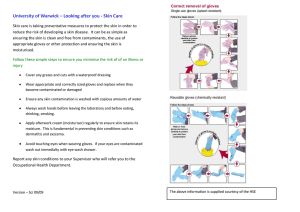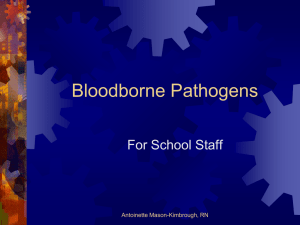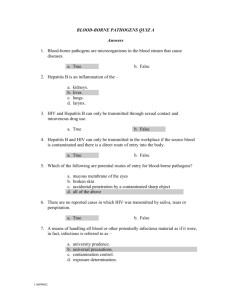Cleaning and Disinfecting Surfaces Contaminated with Blood Background/General
advertisement
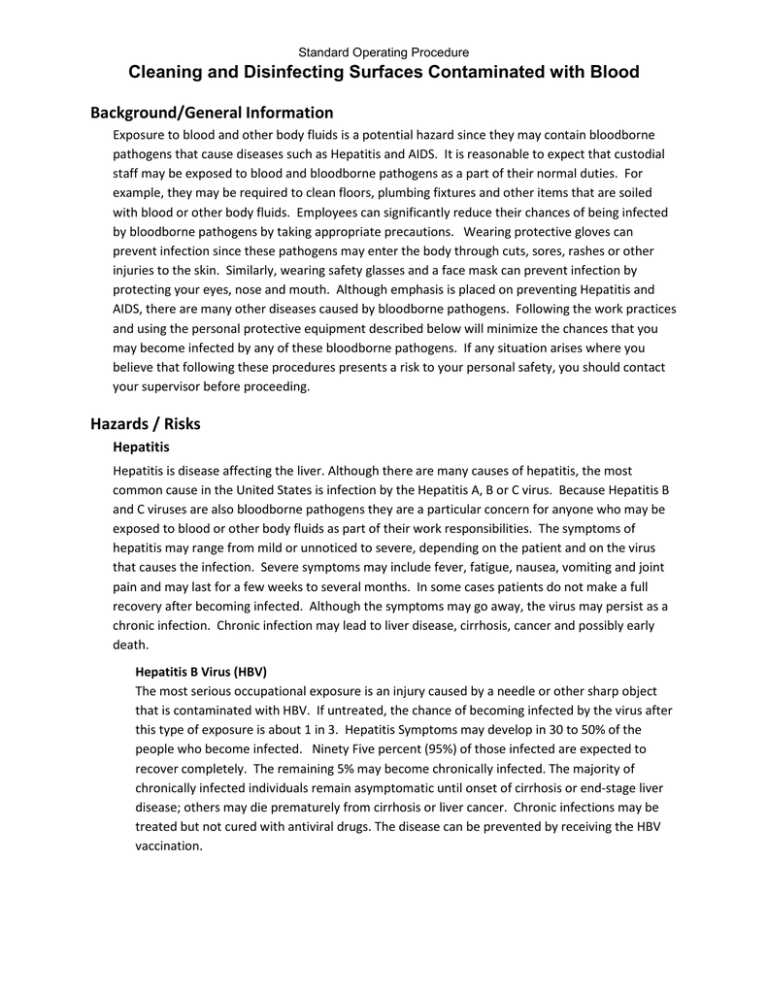
Standard Operating Procedure Cleaning and Disinfecting Surfaces Contaminated with Blood Background/General Information Exposure to blood and other body fluids is a potential hazard since they may contain bloodborne pathogens that cause diseases such as Hepatitis and AIDS. It is reasonable to expect that custodial staff may be exposed to blood and bloodborne pathogens as a part of their normal duties. For example, they may be required to clean floors, plumbing fixtures and other items that are soiled with blood or other body fluids. Employees can significantly reduce their chances of being infected by bloodborne pathogens by taking appropriate precautions. Wearing protective gloves can prevent infection since these pathogens may enter the body through cuts, sores, rashes or other injuries to the skin. Similarly, wearing safety glasses and a face mask can prevent infection by protecting your eyes, nose and mouth. Although emphasis is placed on preventing Hepatitis and AIDS, there are many other diseases caused by bloodborne pathogens. Following the work practices and using the personal protective equipment described below will minimize the chances that you may become infected by any of these bloodborne pathogens. If any situation arises where you believe that following these procedures presents a risk to your personal safety, you should contact your supervisor before proceeding. Hazards / Risks Hepatitis Hepatitis is disease affecting the liver. Although there are many causes of hepatitis, the most common cause in the United States is infection by the Hepatitis A, B or C virus. Because Hepatitis B and C viruses are also bloodborne pathogens they are a particular concern for anyone who may be exposed to blood or other body fluids as part of their work responsibilities. The symptoms of hepatitis may range from mild or unnoticed to severe, depending on the patient and on the virus that causes the infection. Severe symptoms may include fever, fatigue, nausea, vomiting and joint pain and may last for a few weeks to several months. In some cases patients do not make a full recovery after becoming infected. Although the symptoms may go away, the virus may persist as a chronic infection. Chronic infection may lead to liver disease, cirrhosis, cancer and possibly early death. Hepatitis B Virus (HBV) The most serious occupational exposure is an injury caused by a needle or other sharp object that is contaminated with HBV. If untreated, the chance of becoming infected by the virus after this type of exposure is about 1 in 3. Hepatitis Symptoms may develop in 30 to 50% of the people who become infected. Ninety Five percent (95%) of those infected are expected to recover completely. The remaining 5% may become chronically infected. The majority of chronically infected individuals remain asymptomatic until onset of cirrhosis or end-stage liver disease; others may die prematurely from cirrhosis or liver cancer. Chronic infections may be treated but not cured with antiviral drugs. The disease can be prevented by receiving the HBV vaccination. Hepatitis C Virus (HCV) The chance of becoming infected by HCV after an occupational exposure to blood from a person infected with HCV is about 1.8%. The symptoms of HCV infection are similar to those caused by HBV, but the symptoms only occur in only 20 to 30% of infected individuals. Chronic infection that may lead to liver disease, cirrhosis or liver cancer, is expected to occur in 75 to 85% of infected individuals. The disease may be treated but not cured with anti-viral drugs. There is no HCV vaccine. Human Immunodeficiency Virus (HIV) The overall risk of contracting HIV as a result of an occupational exposure to blood or other potentially infectious materials is low (Estimated at 0.3%). Within a few weeks of being infected with HIV, some people may develop flu-like symptoms that last for a week or two, while others may have no symptoms at all. AIDS occurs in the late stages of HIV infection, when a person's immune system is severely damaged and has difficulty fighting diseases. Untreated HIV infection is also associated with cardiovascular disease, kidney disease, liver disease, and cancer. There is currently no HIV vaccine or cure for AIDS. However, treatment with anti-HIV drugs has been successful in delaying the onset of AIDS. Without treatment people infected with HIV may develop to AIDS in just a few years. Currently, people can live much longer - even decades - with HIV before they develop AIDS. Personal Protective Equipment (PPE) to prevent exposure to bloodborne pathogens Gloves • Gloves made from nitrile, or another appropriate material must be worn when cleaning and disinfecting areas contaminated by blood or other potentially infectious materials. • Never touch your eyes, nose, mouth or your face while wearing gloves. • To prevent the spread of contamination gloves must be removed before touching “clean” surfaces such as door knobs, cell phones, etc. • Do not wash or reuse disposable gloves. • Gloves must be changed when they become contaminated, or if they are torn, punctured or otherwise compromised. • Gloves must be removed in a manner that prevents the unintentional transfer of hazardous or infectious material from the outside contaminated surfaces of the glove to unprotected skin or clothing. • Consider wearing two pair of gloves for particularly hazardous work as this permits removal of a contaminated outer glove with minimal risk of exposure. • Contaminated single use gloves are disposed as biological waste. Eye and Face Protection • Wear safety glasses and face mask or a face shield as necessary to protect your eyes and face from splashes or spray. • Do not put on or remove face/eye protection while wearing gloves that are potentially contaminated. • Individuals who wear contact lenses should also wear eye protection. Contact lenses do not provide protection to the eyes. Foreign material splashed into the eye may become trapped under the contact lens and result in more serious injury. Additional PPE Coveralls, aprons, shoe covers, etc., may be necessary for clean-up of large amounts of blood or other body fluids. Clean-up Procedure: Materials Needed The following may be needed for clean-up of blood and other potentially infectious materials. • 10% bleach solution, Oxivir TB spray or another approved disinfectant. • gloves, coveralls, shoe covers, safety glasses, face mask • plastic bags/liners • 5 gallon bucket with lid, labeled for biohazard waste. • brush and dustpan, or tongs or forceps for picking up sharps • disposable paper toweling Evaluate the area that needs cleaning and select appropriate personal protective equipment. • For small amounts of blood or other potentially infectious materials, a pair of gloves may be sufficient to protect you from exposure. • For larger amounts of blood or body fluids coveralls, shoe covers, safety glasses, a face mask and a pair of gloves may be required to protect you from exposure. • Protecting yourself should be your priority. Wearing more PPE than necessary is better than not wearing enough. If you are unsure about selecting appropriate PPE talk to you supervisor. Decontamination and Cleaning 1. If you are planning to use bleach for decontamination, prepare a fresh bleach solution by adding 1 cup of bleach to 1 gallon of water. Do not use bleach on carpeted areas unless the fabric is color-fast. Use Oxivir TB as an alternative to bleach (always test in an area that is not easily seen before proceeding). 2. Cover the area with paper towels to avoid tracking the blood or potentially infectious materials to other areas. 3. Pick up any sharp objects (broken glass, pieces of metal, needles, etc.) using a dustpan and brush, or tongs and place them into the five gallon bucket that is lined with a plastic bag/liner. 4. Cover any remaining areas of the spill with paper towels 5. Pour the freshly mixed bleach solution over the paper towels until they are saturated. If you are using Oxivir TB spray the paper towels until they are saturated. On carpeted areas make sure the disinfectant also saturates the carpet. 6. Wait at least 10 minutes for bleach / disinfectant to work. 7. Working from the edges toward the center, carefully clean the area using additional paper towels as needed to absorb the disinfectant. 8. If a Scrub brush is needed to remove the material from hard porous surfaces such as concrete be sure you are wearing appropriate PPE to protect yourself from splashes or spray. 9. If cleaning large amounts blood, a second application of disinfectant may be necessary to ensure that surfaces are adequately cleaned and disinfected. 10. After the contaminated area has been cleaned, use fresh water to remove bleach/disinfectant residue from all surfaces. Disposal 1. Place disinfected material (broken glass, paper towels, gloves and other disposable materials) into a 5 gallon plastic bucket that is lined with a plastic bag/liner. Use a double bag if necessary to prevent leakage. 2. Carefully gather the bag around waste and tie the top. Try not to trap excess air the bag when tying the top. 3. Secure the lid on the 5 gallon bucket. 4. Contact the biosafety officer for a pickup and disposal (dcdixon@mtu.edu or 7-2131). 5. Keep the biohazard waste in a secured area until it can be picked up. Decontaminate Re-usable Equipment Use the bleach solution or Oxivir TB to decontaminate all re-useable tools or protective equipment used in the cleanup. This includes dustpans, brooms, forceps, buckets, mops etc. Anything that cannot be effectively decontaminated (the disinfectant must be able to make contact with all surfaces) must be disposed as waste. Wash Your Hands If hand-washing facilities are not available at the job site use disinfectant wipes and then wash your hands as soon as possible. Occupational Exposures If you are exposed to blood or other potentially infectious materials follow these steps: • Skin exposure: Vigorously wash affected skin with plenty of soap and water for up to 10 minutes. If necessary remove contaminated clothing. Avoid the use of bleach or other disinfecting agents that are caustic to the skin, • Cuts or punctures of the skin: Wash the affected area thoroughly with soap and water, and rinse the area for up to 10 minutes. Allow small cuts and punctures to bleed freely. The application of antiseptics or disinfectants may be beneficial, however, avoid the use of bleach and other disinfecting agents that are caustic to the skin. • Eye exposure: Wash eyes for at least 10 minutes with copious amounts of water, lifting the upper and lower eyelids occasionally. Be careful not to wash the contaminant into the unaffected eye. • Report the incident to your supervisor and seek follow-up medical attention and evaluation.
